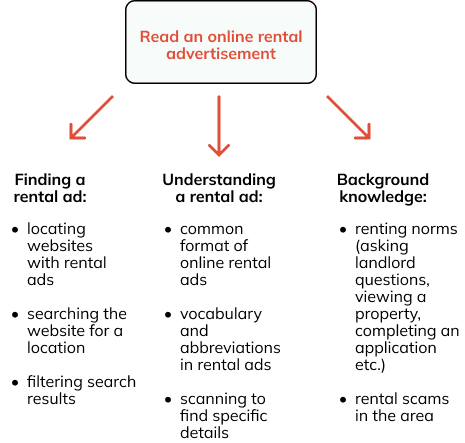Task Analysis
Language learning in LINC is task-based, and the goal of task-based learning is to successfully accomplish real-world communicative tasks. Often, instructional planning begins with choosing appropriate real-world tasks. Engaging in a process of task analysis helps you to identify what learners need to know and be able to do with language to successfully complete the real-world task. This analysis informs your choice of assessment tasks, skill-using tasks and skill-building activities.
Task analysis is a process of breaking down a task into specific language and socio-cultural elements needed for successful completion of the task, in order to identify and plan the steps in instruction to prepare learners for the task. Task analysis includes considering the following:
- Theme: What theme is appropriate for this task?
- CLB Descriptors: What CLB competency does the task relate to, and what are its indicators of ability?
- Vocabulary: What words, formulaic expressions and idiomatic language are typically used in this type of task? What range of this vocabulary is appropriate for the target CLB level?
- Grammar: What grammar, including structure and mechanics for reading and writing, will learners need?
- Pronunciation and mechanics: What elements of pronunciation or mechanics are required for this task? For example, intonation in questions, sentence stress, capitalization in a resume, or punctuation in compound sentences.
- Knowledge and strategies: What functional and sociolinguistic knowledge will learners need? What strategies can learners use for this task?
- Cultural considerations: Which cultural considerations are important for this task? What are the cultural expectations of this task in Canada?
- Digital skills: Is this task typically completed online or in digital format? Are there digital skills that will be helpful for completing this task?
- Equity, diversity and inclusion: How can concepts related to equity, diversity and inclusion be incorporated in this task? Does this task pose barriers for specific groups of people?
- Trauma-informed strategies: Are there any likely triggers for trauma in this task? How can trauma-informed strategies be incorporated into this task?
All of these elements are integrated into task-based language teaching and taught within the context of a task. When you have considered each of these areas, and observed learners to determine their strengths and knowledge gaps, you can identify which skill-building activities will help learners develop the knowledge and skills to accomplish the task. You can also consider how the task, or portions of the task, can be practiced as a skill-using task.
There is no one way to conduct a task analysis. Below is just one example:

For example, learners working toward the real-world task “read a rental advertisement” in a module on finding a place to live could engage in many potential skill-building activities, including:
- matching pictures of housing types with their corresponding words
- identifying abbreviations in a housing advertisement and writing the full words
- locating and scanning online rental ads to find specific details
- reading two different ads and filling out a table to compare and contrast information from the ads
EAL Literacy Learners
A task analysis for EAL literacy instruction may include everything mentioned above, as well as considering specific EAL literacy skills and strategies that may be needed:
- Oral skills: How can I build oral familiarity with the language in the task before asking learners to do the reading or writing for this task?
- EAL literacy skills: What reading or writing skills are needed to complete this task?
- Numeracy: What numeracy skills, if any, are needed for this task?
Draw from the CLB: ESL for ALL for specific EAL literacy skills.
Helpful Hint
You would benefit from familiarity with previous sections under the “Task-Based Approach” Essential Component.
Useful Resources and References
Related Essential Components
- Task-Based Instruction
- Real-World Tasks (RWTs)
- Assessment Tasks
- Skill-Using Tasks
- Skill-Building Activities
- Themes
- Canadian Language Benchmarks (CLB)
- Intercultural Competence
- Digital and Media Literacy
- 2SLGBTQIA+ Inclusion
- BIPOC and Anti-Racism
- Francophone Perspectives
- Gender Based Analysis (GBA) Plus and Intersectionality
- Indigenization
- Women and Gender Equality
- EAL Literacy Learners
External Resources
- CLB: ESL for Adults
- CLB: ESL for ALL
- CLB Support Kit
- CLB: ESL for ALL Support Kit
- Introduction to Task-Based Language Teaching
- Alberta Teachers of English as a Second Language (ATESL) presents task-based language teaching in their curriculum guidelines: Instruction
- Integrating CLB Assessment into Your ESL Classroom
References
- Nunan, D. (2004). Cambridge University Press. Task-Based Language Teaching. Task-Based Language Teaching (cambridge.org)
- Ellis, R. (2009). Task-Based Language Teaching: Sorting out the Misunderstandings. International Journal of Applied Linguistics, 19, 221-246. Task‐based language teaching: sorting out the misunderstandings – Ellis – 2009 – International Journal of Applied Linguistics – Wiley Online Library
- Willis, D. & Willis, J. (2007). Oxford University Press. Doing task-based teaching.


